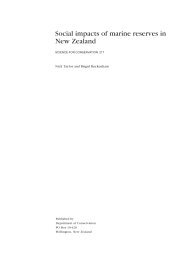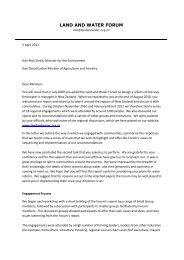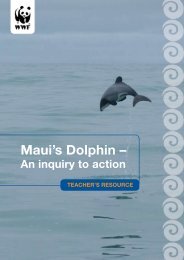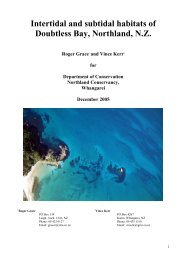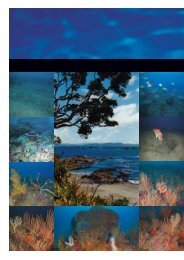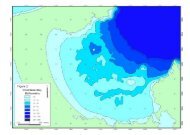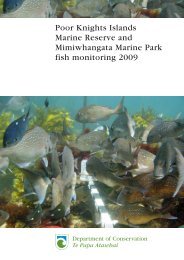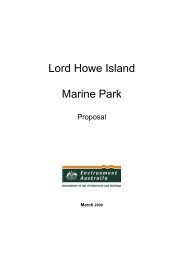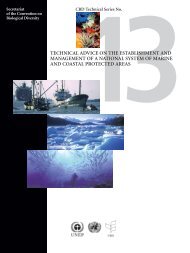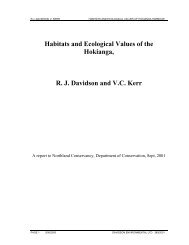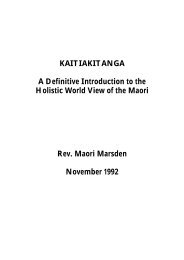WWF Shining a spotlight on the biodiversity of ... - MarineNZ.org.nz
WWF Shining a spotlight on the biodiversity of ... - MarineNZ.org.nz
WWF Shining a spotlight on the biodiversity of ... - MarineNZ.org.nz
Create successful ePaper yourself
Turn your PDF publications into a flip-book with our unique Google optimized e-Paper software.
Biogenic carb<strong>on</strong>ate/<br />
bryozoan habitats<br />
Map ID number:<br />
16, 4, 21, for example.<br />
Locati<strong>on</strong>: Chief areas are<br />
<strong>the</strong> Three Kings Shelf and<br />
Snares Plateau for extensive<br />
bryomol (Bryozoan-Mollusca)<br />
shell gravel. Large bryozoan<br />
col<strong>on</strong>ies forming habitat occur<br />
in Tasman Bay, Otago Shelf,<br />
and parts <strong>of</strong> Foveaux Strait.<br />
Smaller areas include Mernoo<br />
Bank <strong>on</strong> <strong>the</strong> eastern Chatham<br />
Rise, Stephens Hole in Cook<br />
Strait, Otago Shelf, and parts<br />
<strong>of</strong> Foveaux Strait and <strong>the</strong><br />
Campbell Plateau.<br />
Approximate area: 10,000km 2<br />
Descripti<strong>on</strong> <strong>of</strong> habitat type:<br />
Bryomol gravel envir<strong>on</strong>ments are rich<br />
in three-dimensi<strong>on</strong>ality created by erect<br />
bryozoans, corals, hydroids, sp<strong>on</strong>ges, and<br />
ascidians. This three-dimensi<strong>on</strong>ality is coassociated<br />
with high diversity <strong>of</strong> mobile<br />
epibiota and fish. The highest macrobenthos<br />
diversities are found in <strong>the</strong>se habitats, with<br />
nurseries for commercial fish associated with<br />
at least some <strong>of</strong> <strong>the</strong>m.<br />
Biological attributes:<br />
New Zealand’s currently known marine<br />
<strong>biodiversity</strong> hot spot, Spirits Bay, is<br />
associated with bryomol habitat. Of all<br />
known bryozoan localities in <strong>the</strong> world,<br />
Spirits Bay has <strong>the</strong> highest bryozoan<br />
diversity per unit area. The 300 species<br />
found in just <strong>the</strong> 200km 2 regi<strong>on</strong> <strong>of</strong> <strong>the</strong> bay<br />
are equivalent to <strong>the</strong> diversity <strong>of</strong> <strong>the</strong> entire<br />
bryozoan fauna <strong>of</strong> <strong>the</strong> British Isles. Spirits<br />
Bay, and o<strong>the</strong>r areas in <strong>the</strong> world, can have<br />
high local endemism at species and even<br />
genus level.<br />
One habitat-forming bryozoan species,<br />
Cinctipora elegans, and <strong>the</strong> related northrestricted<br />
Attinopora zealandica, are <strong>the</strong><br />
<strong>on</strong>ly living species <strong>of</strong> <strong>the</strong> endemic family<br />
Cinctiporidae. This family has giant zooids<br />
– <strong>the</strong> largest in <strong>the</strong> entire Stenolaemata class.<br />
The endemic, habitat forming bryozoan<br />
corals <strong>of</strong> Tasman Bay, Celleporaria<br />
agglutinans and Hippomenella vellicata,<br />
have existed in <strong>the</strong> northwest regi<strong>on</strong> <strong>of</strong> <strong>the</strong><br />
South Island since <strong>the</strong> early Miocene period.<br />
Criteria applied:<br />
Species diversity; species richness;<br />
endemism; representati<strong>on</strong>; unusual degree/<br />
proporti<strong>on</strong> <strong>of</strong> biomass; habitat complexity/<br />
diversity.<br />
Status and management:<br />
One small area <strong>of</strong>f Spirits Bay is protected<br />
from bottom trawling.<br />
State <strong>of</strong> informati<strong>on</strong>:<br />
See references below. The state <strong>of</strong><br />
informati<strong>on</strong> for bryozoan tax<strong>on</strong>omy is good,<br />
but <strong>the</strong> “ecology” is <strong>on</strong>ly partially described<br />
(i.e. for places like Spirits Bay).<br />
References and fur<strong>the</strong>r reading:<br />
Battershill et al. (1998), Bradstock and<br />
Gord<strong>on</strong> (1983), Carter et al. (1985), Head<br />
(1985), Nels<strong>on</strong> et al. (1982, 1988a, 1988b),<br />
Probert et al. (1979).<br />
Topographic<br />
generated s<strong>of</strong>tsediment<br />
refugia<br />
Not mapped during<br />
<strong>the</strong> workshop<br />
Locati<strong>on</strong>: Bay <strong>of</strong> Plenty and<br />
potentially throughout <strong>the</strong><br />
Exclusive Ec<strong>on</strong>omic Z<strong>on</strong>e at<br />
various depths<br />
Approximate area: Not<br />
recorded during <strong>the</strong> workshop<br />
Descripti<strong>on</strong> <strong>of</strong> habitat type:<br />
This habitat is comprised <strong>of</strong> remnant areas<br />
<strong>of</strong> shelf slope sediments that have remained<br />
free <strong>of</strong> bottom trawling by virtue <strong>of</strong> <strong>the</strong>ir<br />
proximity to topographic features. The<br />
areas are undisturbed and unfished, but are<br />
o<strong>the</strong>rwise representative <strong>of</strong> shelf and slope<br />
sediment habitats. The sizes <strong>of</strong> <strong>the</strong> refugia<br />
exist <strong>on</strong> a range <strong>of</strong> scales, from less than<br />
1 km to tens <strong>of</strong> kilometres. Such areas are<br />
likely to occur throughout <strong>the</strong> New Zealand<br />
Exclusive Ec<strong>on</strong>omic Z<strong>on</strong>e at various<br />
depths. Examples <strong>of</strong> features that prevent<br />
trawling include rocky outcrops or cany<strong>on</strong>s,<br />
cableways, and explosives dumping grounds.<br />
Biological attributes:<br />
S<strong>of</strong>t sediment refugia have high species<br />
diversity (including muricid gastropods)<br />
and <strong>the</strong> full range <strong>of</strong> populati<strong>on</strong> size and age<br />
structures.<br />
Criteria applied:<br />
Degree <strong>of</strong> disturbance; unusual degree/<br />
proporti<strong>on</strong> <strong>of</strong> biomass.<br />
Status and management:<br />
The refugia are probably now <strong>the</strong> <strong>on</strong>ly sites<br />
in nor<strong>the</strong>astern New Zealand that c<strong>on</strong>tain<br />
unmodified slope fauna and are likely to be<br />
Horse mussel and s<strong>of</strong>t-sediment refugia, Fiordland<br />
unc<strong>on</strong>tested areas for c<strong>on</strong>servati<strong>on</strong> status.<br />
If not c<strong>on</strong>served, <strong>the</strong>se refugia are likely<br />
to decrease in number and size as fishing<br />
technology develops to allow trawling in<br />
areas with some rocky outcrops.<br />
State <strong>of</strong> informati<strong>on</strong>:<br />
The fisheries trawl database (owned by<br />
<strong>the</strong> Ministry <strong>of</strong> Fisheries, administered<br />
by NIWA) has good records <strong>of</strong> trawling<br />
intensity <strong>on</strong> scampi grounds <strong>on</strong> different<br />
areas. Interrogati<strong>on</strong> <strong>of</strong> this database in<br />
combinati<strong>on</strong> with <strong>the</strong> latest NIWA swath<br />
map should identify <strong>the</strong> exact locati<strong>on</strong> <strong>of</strong><br />
refuges from trawling.<br />
References and fur<strong>the</strong>r reading:<br />
Cryer et al. (2002).<br />
©NIWA/Ken Grange<br />
64 ■ BIODIVERSITY – NEW ZEALAND’S MARINE ECOREGION





